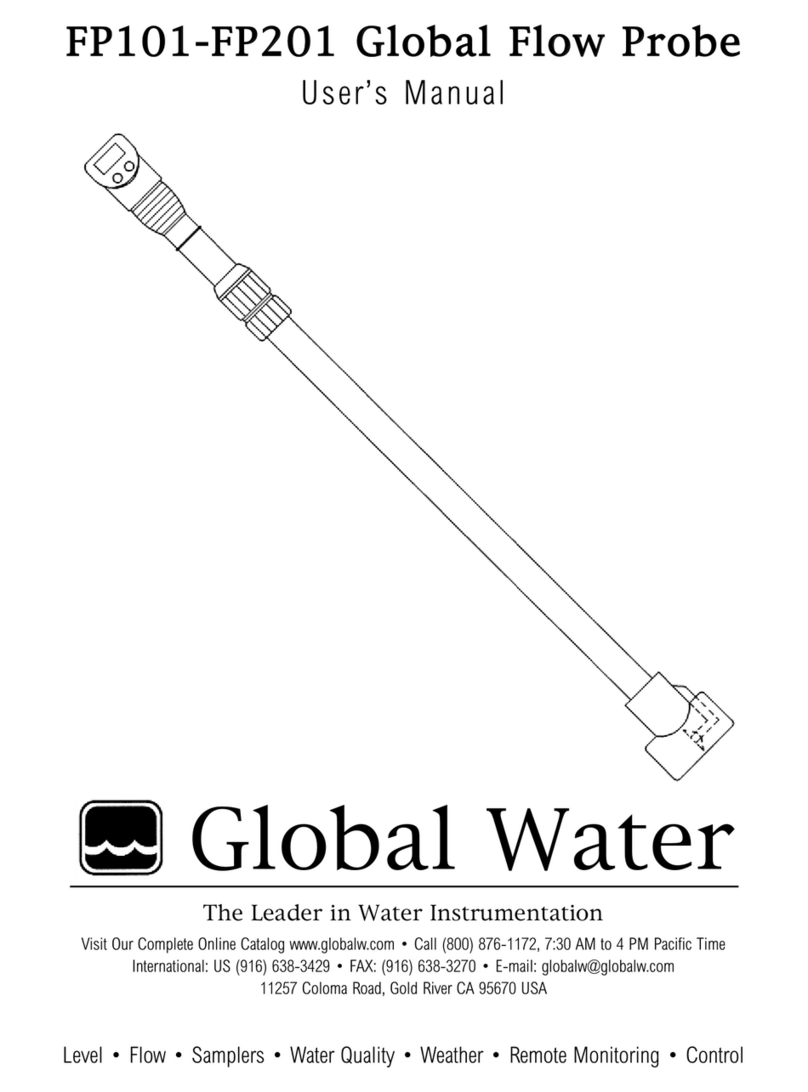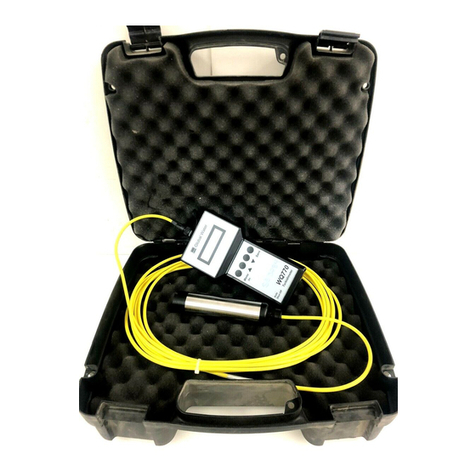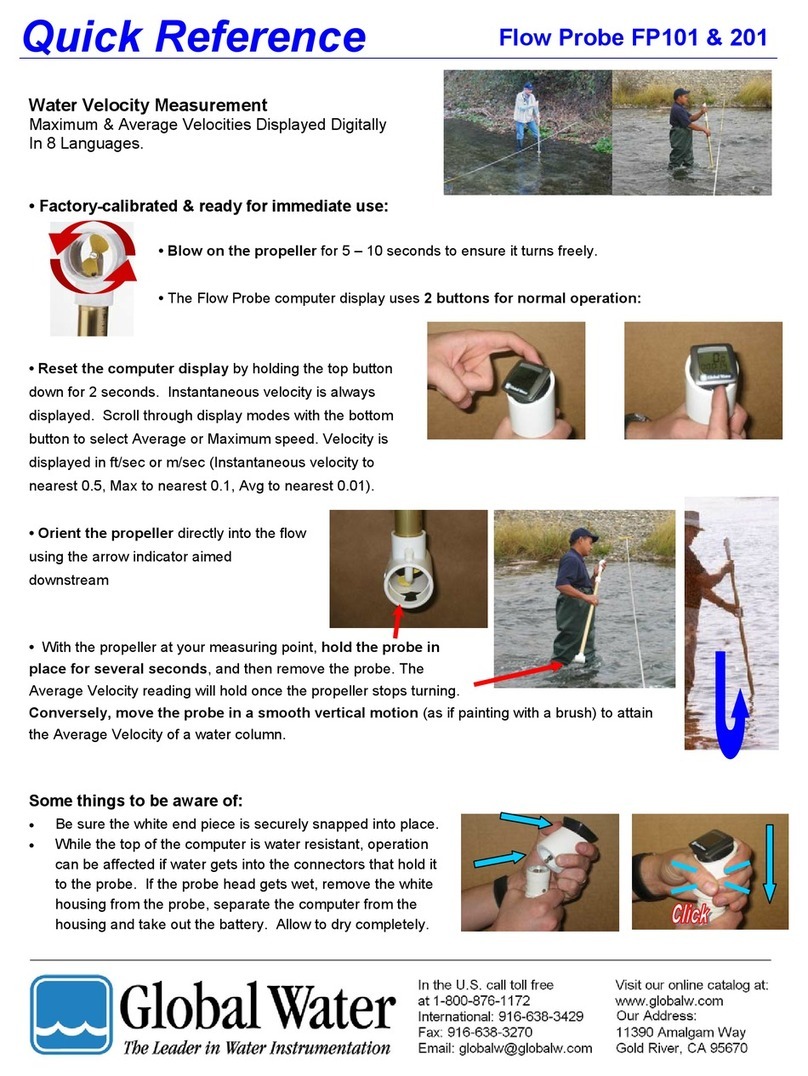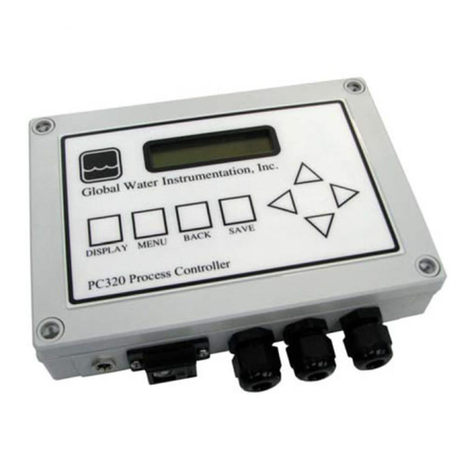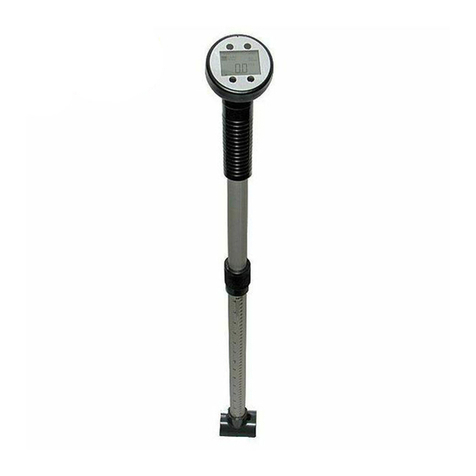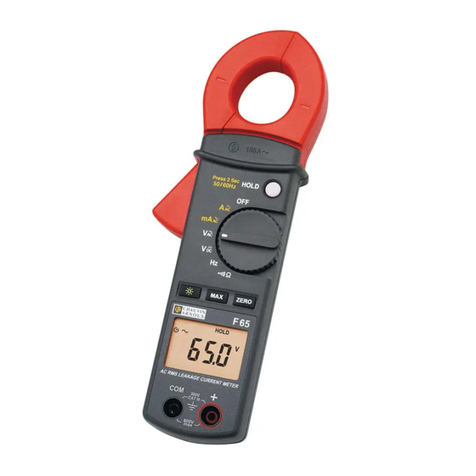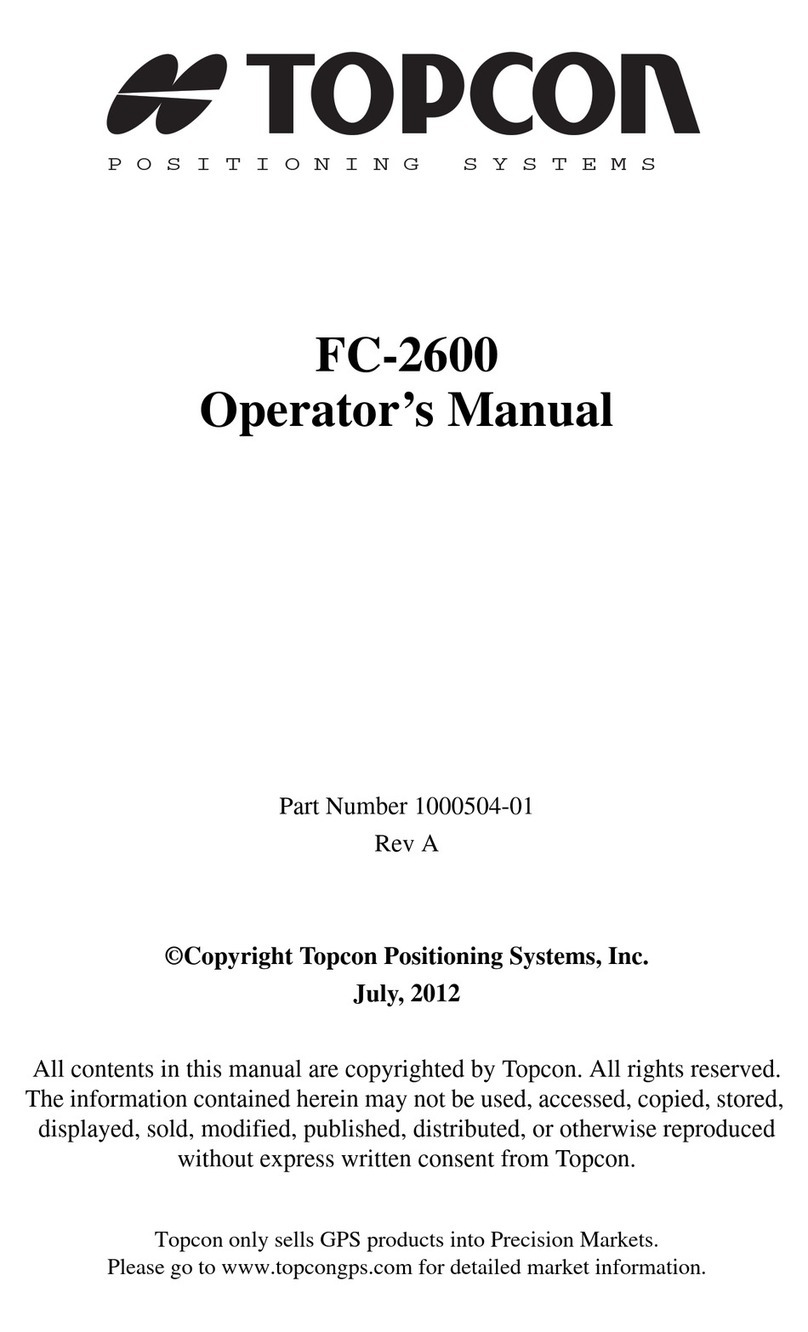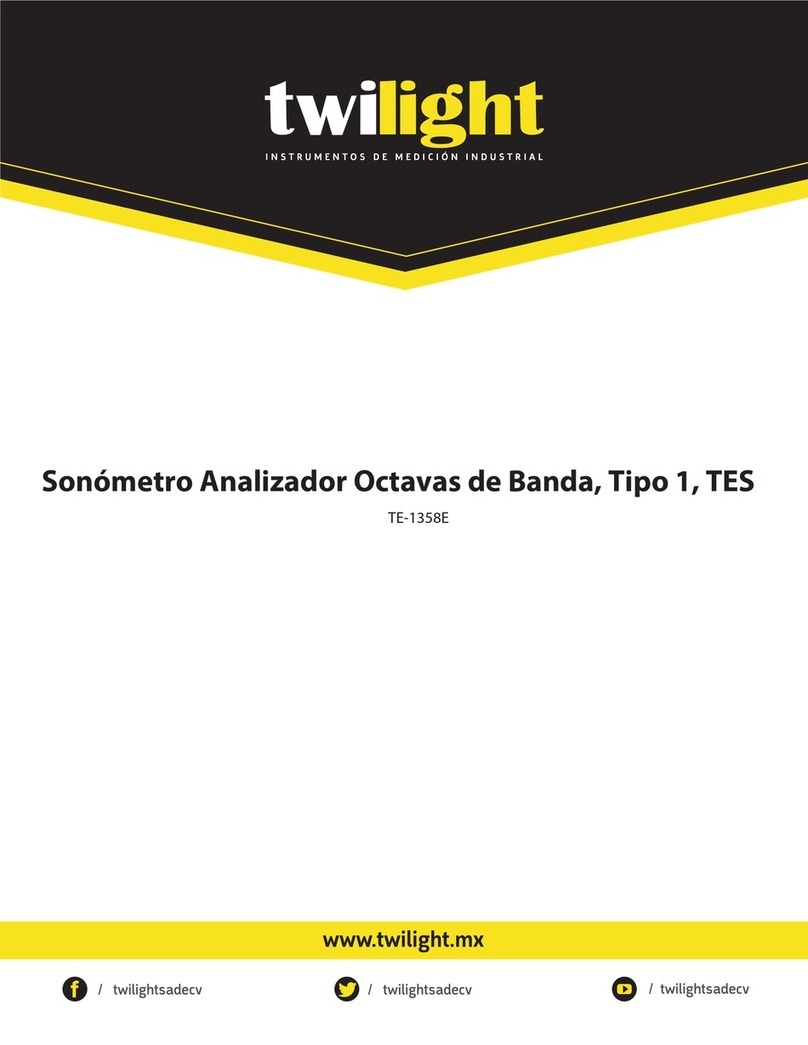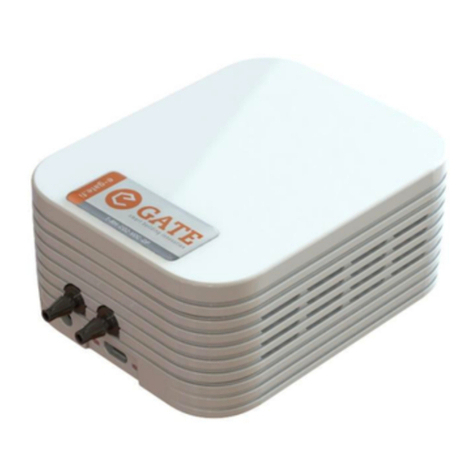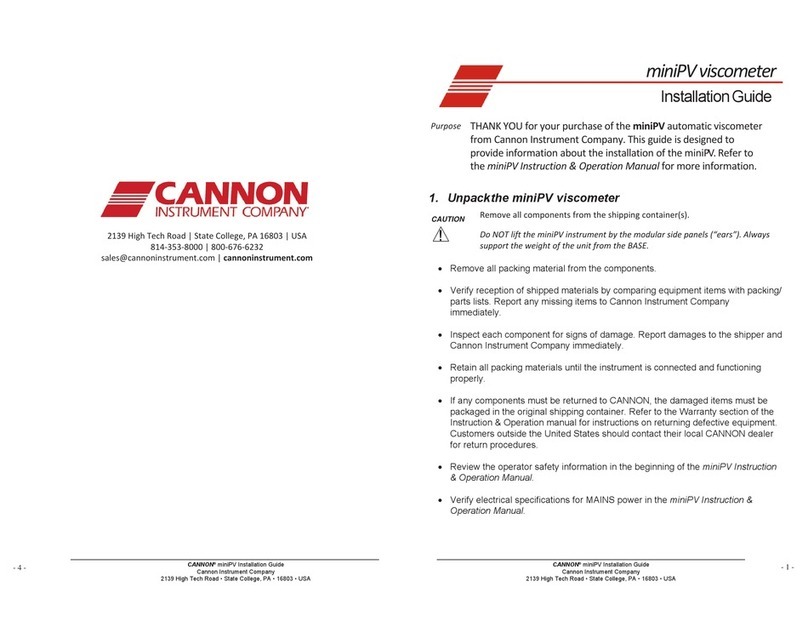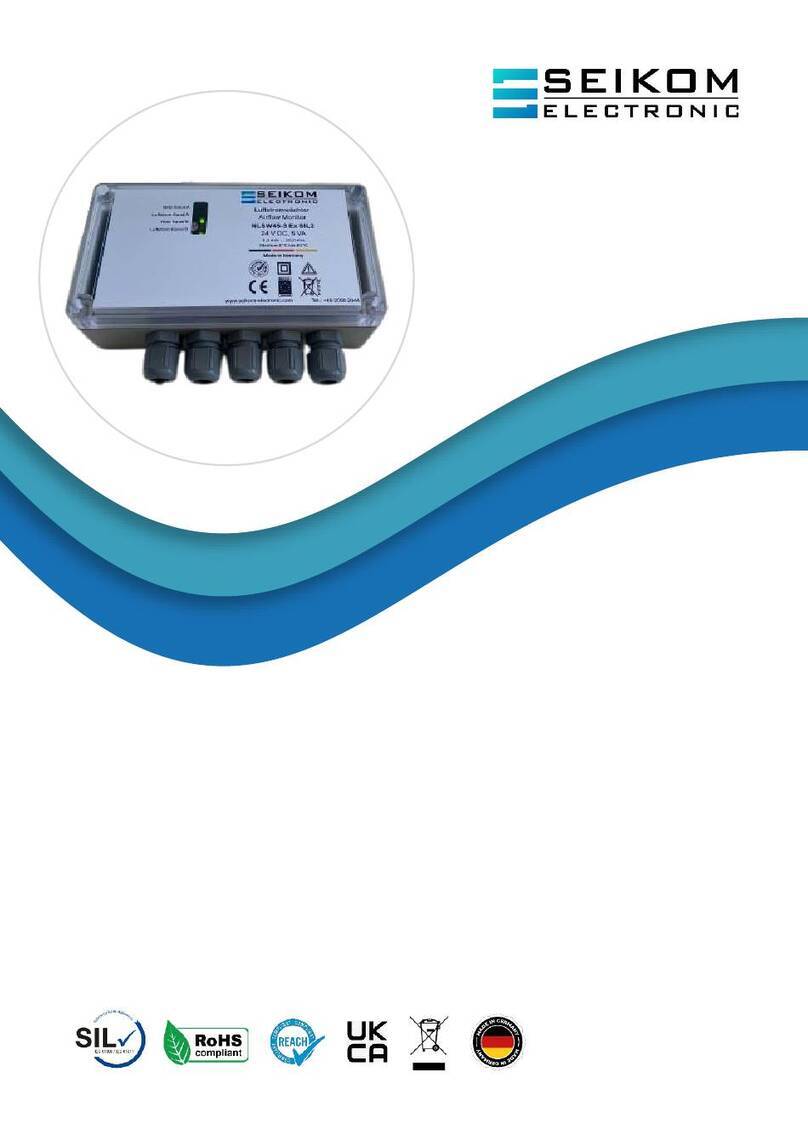globalwater FC220 User manual

Global Water
800-876-1172 •globalw.com
- 1 -
Global Water
Instrumentation, Inc.
11390 Amalgam Way
Gold River, CA 95670
T: 800-876-1172
Int’l: (916) 638-3429, F: (916) 638-3270
FC220 Flow Monitor
02-056
10/14/10

Global Water
800-876-1172 •globalw.com
- 2 -
Congratulations on your purchase of the Global Water FC220 Flow
Monitor. This instrument has been quality tested and approved for
providing accurate and reliable measurements. We are confident that you
will find the monitor to be a valuable asset for your application. Should you
require assistance, our technical staff will be happy to help.
Table of Contents
I. FC220 Flow Monitor Description •••Page 3
II. FC220 Specifications ••••5
III. Flow Calculation Modes •••••6
IV. Switch Settings •••••8
V. Sensor Input •••••9
VI. 4-20mA Output •••••9
VII. Relay Operation ••••••9
VIII. Power Saving Mode •••••10
IX. Scientific Notation •••••10
X. Totalizer ••••••10
XI. Programming Setup Parameters ••••11
XII. Data Logger Option •••••17
XIII. Maintenance and Troubleshooting •••18
XIV. Appendix A: Terminal Strip Diagram •••21
XV. Appendix B: Flume and Weir Equation Parameters •22
* Copyright ©Global Water Instrumentation, Inc. 2010

Global Water
800-876-1172 •globalw.com
- 3 -
I. FC220 Flow Monitor Description
The Global Water FC220 Flow Monitor is a reliable and accurate instrument for
measuring and totalizing water flow in a wide variety of applications. Water level is
measured using Global Water’s popular WL400 level sensor, WL700 ultrasonic
sensor, or almost any other 4-20mA, 0-5V or 0-1V water level sensor. Flow is then
calculated by the microprocessor using a variety of different techniques. The backlit
LCD display shows real-time flow, water level or total flow in user selectable units;
and the 8-button keypad easily guides the user through the versatile setup menus.
The FC220 supports several different types of flow calculation modes. Over 40
preprogrammed flume and weir equations are included. For monitoring in round pipes
and open rectangular channels; the Manning’s Equation mode allows the user to enter
their own parameters for material type, slope and pipe or channel dimensions.
Standard flow equations can also be defined; which can calculate flow for almost all
flumes and weirs. Another mode lets the user enter parameters for a best fit 3rd order
polynomial that is useful for calculating flow based on empirical data and lookup
tables. In addition, a factory programmable lookup table can be permanently stored in
the processors memory for monitoring in applications where a single equation can’t
accurately predict flow, such as streambeds and open channels with complicated
geometry. A 16-character name can be programmed into the FC220 by the user to
identify the installation site or show other information about the configuration.
Water flow is displayed with up to 7 digits which allows for the display of flow in the
largest applications. The totalizer records flow volume up to 9 digits with floating
point and scientific (engineering) notation supported in non-volatile memory, and is
password protected from reset. The maximum recordable total volume is more than
one trillion cubic feet. Available volume units are cubic feet, gallons, million gallons,
cubic meters and liters; time units include seconds, minutes, hours and days. This
allows for the display of flow in 20 different user defined units. Water level is
calibrated and displayed in feet, inches, meters or centimeters; and a level offset
function allows the measured level to be adjusted to compensate for variations in
sensor installation. The engineering units for all display modes and setup parameters
are independently programmable, which allows for the greatest possible versatility.

Global Water
800-876-1172 •globalw.com
- 4 -
Four independent relay outputs are provided for triggering external devices like water
samplers and monitoring devices. These relays can be separately programmed to
trigger based on volume per pulse, and threshold settings can be used to limit
triggering to flows above preset levels. There is also an accurate and scalable 4-20mA
output provided for monitoring flow using data loggers and PLC devices. An internal
USB data logger is available as a factory option that allows the historical flow data to
be recorded, as well as the exact time of each relay trigger event. Free software is
provided for programming the data logger, downloading flow and relay data, and
exporting to spreadsheets. Programmable power saving features allow the supply
current to be reduced, which is important in remote monitoring applications.
A 16 character by 2 line LCD display can show either the current flow rate, the water
level, or the volume in the totalizer. The 8-button keypad allows the selection of the
display modes, and the programming of the setup parameters. The DISPLAY button
toggles the LCD display between the flow rate, the water level, and the totalizer. This
button also allows the quick exit from the setup menus when in any setup mode.
Holding the MENU button down for two seconds enters the setup menu. In setup
mode, the MENU button moves from one menu selection to another. The BACK
button moves the user backward through the various setup options. The SAVE button
will save a setup parameter to memory. The UP, DOWN, LEFT and RIGHT arrow
buttons are used to select and change setup parameters.
Note:
The FC220 flow monitor requires a level sensor to operate. Two and three wire level
sensors with 4-20mA, 0-5 volt and 0-1 volt outputs are supported. A sensor is not
supplied with the FC220, contact Global Water for more information on available
sensors.

Global Water
800-876-1172 •globalw.com
- 5 -
II. FC220 Specifications:
Power Requirements: 12VDC or 18-24VDC Input, +/-10%
Supply Current: 13mA + Sensor Current + Backlight + 4-20mA Output
150mA Maximum Total Current
Backlight Current: 23mA when on
Internal Fuse: 315mA
Power Adaptor: 18VDC Universal Power Supply, 90-220VAC Input
Equation Formats: Manning’s Equation for Round Pipes
Manning’s Equation for Rectangular Channels
Standard Flow Equation: Q=A*(B+Ch)^D
3
rd Order Polynomial: Q=A+Bh+Ch^2+Dh^3
Stored Flumes: H Type: 0.5, 0.75, 1.0, 1.5, 2.0
HS Type: 0.4, 0.6
Parshall: 1”, 2”, 3”, 6”, 9”, 12”, 24”, 36”, 48”, 60”, 72”
Palmer-Bowlus: 4”, 6”, 8”, 10”, 12”, 15”, 18”, 24”, 30”, 36”
Trapezoidal: 60º
Stored Weirs: Rectangular: 1’, 2’ 3,
V-Notch: 22.5º, 30º, 45º, 60º, 90º, 120º
Cipolletti: 1’, 1.5’, 2’, 3’, 4’
Lookup Table: One, Factory Programmable Only
Output Relays: 4 Independent SPDT Relays, Pulse On Time = 1 Second
Contact Rating: 8A @ 250VAC, 5A @ 30VDC Resistive
Level Sensor Input: 2-Wire or 3-wire, 4-20mA, 0-5VDC, 0-1VDC
Output: 4-20mA Scalable
Display/Keypad: 16 Character x 2 Line Backlit LCD, 8-Button Tactile Keypad
Flow Capacity: 7 Digit Maximum, Auto-Floating point
Totalizer Capacity: 9 Digit Maximum
Auto-Floating Point, Engineering notation supported
Max Volume = 1.0995E12 Cubic Feet (1.0995 x 10^12 Ft³)
Level Capacity: 5 Digit Maximum
Display Resolution: 3 Decimal Places Maximum, Auto-Adjusting
Accuracy: Sensor Accuracy + Equation/Table Error + 0.1% + 1 Digit
Level Units: Feet, Inches, Meters, Centimeters
Volume Units: Cubic Feet, Gallons, Million Gallons, Cubic Meters, Liters
Time Units: Seconds, Minutes, hours, Days
Flow Units: 20 Combinations of Volume and Time Units Above
Dimensions: 7.1”W x 5.1”H x 1.4D (180mm x 130mm x 35mm)
Weight: 1 lb

Global Water
800-876-1172 •globalw.com
- 6 -
III. Flow Calculation Modes
The FC220 determines flow from water level in several different ways. Standard flow
equations, Manning’s Equation, polynomials or a lookup table can all be used. The
following equation formats calculate flow in cubic feet per second based on the
measured water level in feet. A conversion is made by the microprocessor so that the
display and 4-20mA output work in the user defined flow units.
Flow Equation:
There are standard flow equation parameters for over 40 flumes and weirs stored in the
FC220. The user also has the ability to enter their own parameters for the flow
equation in the form of:
Q = A * (B+Ch)^D
Where:
Q = Flow in Cubic Feet Per Second
A - D = User Programmable Coefficients. If B is not used, enter zero
h = Water Level in Feet
If this mode is selected, the user is prompted to enter the four parameters in the
equation, A, B, C and D.
Manning’s Equation:
The Manning’s Equation is a widely accepted way of calculating the flow in any
gravity feed partially full channel of known geometry. Two applications are
supported, round pipes and rectangular channels. The equation is in the form of:
Q = ( 1.486 / n ) * WA * ( WA / WP ) ^ 0.6667 * ( Slope ) ^ 0.5
Where:
Q = Flow in cubic feet per second
n = Roughness Factor
WA = Wetted Area in Feet², cross sectional area of the water at any given depth
WP = Wetted Perimeter in ft, length of bottom and sides that is wet at any given depth
Slope = Slope of channel or pipe, drop in elevation divided by length of drop.

Global Water
800-876-1172 •globalw.com
- 7 -
In these modes the user is either prompted to enter the pipe diameter or rectangular
channel width, in user programmable units. The WA and WP are automatically
calculated based on the diameter or width, and the measured water level.
The roughness factor is determined by the construction material, typical values are:
0.010 Plastic, other smooth surfaces
0.012 Smooth unpainted steel
0.013 Painted steel, coated cast iron
0.013 Clay drainage tile, smooth asphalt
0.013 Finished concrete
0.014 Vitrified clay sewer tile
0.014 Uncoated cast iron
0.017 Unfinished concrete
0.024 Corrugated metal storm drain
Polynomial:
A best fit 3rd order polynomial can also be used to calculate flow. This is useful when
you need to find an equation that best fits measured data or a lookup table. The
equation is in the form of:
Q = A + Bh + Ch² + Dh³
Where:
Q = Flow in cubic feet per second
A - D = User defined coefficients
h = Water level in feet
When selecting this mode, the user is prompted to enter the values for A, B, C and D.
Look-Up Table:
For applications where a single equation does not properly calculate flow, a single
look-up table can be programmed into the FC220. This is a factory programmable
option only. Data for this table must be provided to Global Water in two columns and
no more than 200 lines. The first column is water level in feet and the second column
is the flow in cubic feet per second at that water level. Liner interpolation is
automatically done when a measured water level is between two data points.

Global Water
800-876-1172 •globalw.com
- 8 -
IV. Switch Settings
Inside the FC220 is a bank of 8 switches which are used to select the sensor type and
power input. Select the switches as follows:
Select only one of SW1 and SW2, leave the other switch off
SW1: ON, Sensor power is 12 volts
SW2: ON, Sensor power is 18-24 volts depending on the voltage input to the
FC220. Note this feature is not available when running from a 12 volt battery
SW3: ON, Sensor power is continuous
SW3: OFF, Sensor power is switched on and off by the microprocessor in power
saving mode. If not using power saving mode, set SW3 to ON.
SW4: ON, Sensor type is 4-20mA
SW4: OFF, Sensor type is 0-5 VDC or 0-1 VDC
SW5: ON, Sensor type is 4-20mA or 0-5 VDC
SW5: OFF, Sensor type is 0-1 VDC
SW6: This switch is unused
Select only one of SW7 and SW8, leave the other switch off
SW7: ON, Power input to the FC220 is 18-24 VDC
SW8: ON, Power input to the FC220 is 12 VDC

Global Water
800-876-1172 •globalw.com
- 9 -
V. Sensor Input
The FC220 accepts any water level sensor with a 4-20mA, 0-5VDC or 0-1VDC output.
Available power for the sensor depends on the power input to the FC220. When
powering the FC220 from 12 volts, the sensor power is also 12 volts. If you are
running from a power supply of 18-24 volts, the sensor power can be selected from
either a regulated 12 volt supply, or directly from the 18-24 volt input. The power can
also be connected continuously or it can be set to be turned on and off by the FC220
when using power saving mode. In this mode the sensor is turned on at user defined
intervals for a programmable warm-up time, then turned off again to conserve power.
VI. 4-20mA Output
A 4-20mA output is provided that is proportional to water flow. This allows the water
flow history to be recorded by an external data logger or PLC, or by the internal data
logger option, or both. The output is scalable and allows the user to select the flow
rates that are proportional to the 4mA and 20mA output currents.
VII. Relay Operation
Four independently programmable relays are provided for triggering external devices.
These outputs are generally intended for triggering water samplers when doing flow
proportional sampling, or for recording by an external data logger or PLC. The relays
are single pole double throw (SPDT) types with common, normally open and normally
closed contacts available at the terminal block inside the FC220. The setup menu
allows the user to independently set the volume of water per output pulse, and set a
threshold level that inhibits the accumulation of volume when the flow is below a user
defined flow rate. The relays are pulsed on for 1 second when the volume of water
since the last pulse equals the volume per pulse setting, and the flow rate is above the
threshold level. Example: The volume per pulse is set to 100 gallons and the
threshold setting is 10 gallons per minute. As long as the flow rate is 10 gallons per
minute (GPM) or more, the water volume is counted and one pulse will occur for
every 10 gallons. If the flow falls below 10 GPM the counting of water volume will
stop until the flow rises above the threshold setting again. If the flow is above 10
GPM long enough to accumulate 5 gallons, then falls below 10GPM, counting stops
but the accumulated 5 gallons is retained. When the flow rate rises above 10GPM
again, only 5 more gallons is needed to output a relay pulse.

Global Water
800-876-1172 •globalw.com
- 10 -
VIII. Power Saving Mode
A power saving mode is provided that allows the operating current to be reduced in
remote monitoring applications. One way this is accomplished is to turn off the LCD
display backlight, this saves about 20mA of current. Three modes allow the user to
turn the backlight on all the time, off all the time, or turn it on for one minute only. In
this last mode, the backlight will come on for one minute when any of the buttons on
the keypad are pressed, then turn off again. The water level sensor can also be turned
on and off periodically to reduce power consumption. The user can program a sample
rate of 0-60 minutes, and can set the sensor warm-up time of 0-60 seconds. Example:
The sample rate is 30 minutes and the warm-up time is 3 seconds. The sensor will be
turned on for 3 seconds every 30 minutes then shut off again. During the time the
sensor is off the flow display and 4-20mA output will indicate a flow based on the last
level reading. The totalizer will continue to be incremented, and the relays will
continue to operate, based on that last reading. After 30 minutes more, a new reading
will be taken and the display and 4-20mA output updated again. Note that using the
4-20mA output will increase the current draw by an amount equal to the output
current.
IX. Scientific Notation
Scientific notation is generally used for displaying very large or very small numbers.
It represents a number as being multiplied by 10 raised to a power, such as 5.67*10^2
being equal to 567 since 10^2 equals 100 (10^2 = 10²). Engineering notation is similar
but only uses 10 raised to a power that is a multiple of 3; like 10^3 (one thousand),
10^6 (one million) or 10^9 (one billion). This notation also replaces “*10^” with “E”
(Exponent) so that 5.67E2 is equivalent to 5.67*10^2 or 567. The notation E2 is also
equivalent to “shift the decimal point to the right two times”. This makes the display
of large numbers easier to read; 5.67E3 is 5.67 thousand or 5670, 5.67E6 is 5.67
million, etc. In the same way, small numbers less that one can be shown as 10 raised
to a negative power, or “shift the decimal point that many times to the left”; such as
5.67E-3 = 0.00567 or 5.67 thousandths, 5.67E-6 = .00000567 or 5.67 millionths.
X. Totalizer
A 9-digit totalizer keeps track of the total volume of water that has accumulated since
the last time the totalizer was reset. The totalizer display supports engineering notation
and can store volumes up to 1.1E12 cubic feet (1.1 x 10^12 or 1.1 trillion) in any of the

Global Water
800-876-1172 •globalw.com
- 11 -
5 selectable volume units. The engineering notation is automatically switched on
when the totalizer volume exceeds the capacity of the 9-digit display.
The totalizer reset function is password protected, preventing a user from entering the
reset menu. This menu also allows the user to change the password. The password is
4 digits in the range of 0000-9999. When shipped from the factory the default
password is 1234. It is recommended that the password be changed before installing
the FC220. If the password is lost or forgotten, contact the Technical Support
department at Global Water.
XI. Programming Setup Parameters
Press the MENU button for 2 seconds to enter the setup menu. Pressing the MENU
button again cycles through the different setup options. Pressing the BACK button
moves backward to the previous display. Pressing the DISPLAY button from any
menu exits to the normal display mode. Press the RIGHT arrow button to enter any of
the setup sub-menus. These sub-menus are Set Level Unit, Set Volume Unit, Set Time
Unit, Calibrate Sensor, 4-20mA Output Calibration, Set Site Info, Power Saving, Relay
Settings, and Totalizer Reset. Note that while in the setup menus, flow calculations
and relay operations will stop. After one minute of inactivity, the FC220 will
automatically return to the main display and operation mode.
The following three menus set the level, volume and time units used for showing data
on the main display. The level unit is used to display the water level. The volume
unit is used to display the totalizer, the total volume of flow since last reset. The
volume and time units are combined to form the flow units of Volume/Time. Other
setup parameters in these menus have independently programmable units. Changing a
unit of measure in one menu will not affect the settings in any other menu.
Set Level Unit:
This unit is used to display water level on the main display. The current setting is
shown in the Set Level Units menu. Use the RIGHT arrow to change the level units.
Use UP and DOWN to select either Feet, Inches, Meters or Centimeters. Press Save to
store the new setting.

Global Water
800-876-1172 •globalw.com
- 12 -
Set Volume Unit:
This unit is used to display the totalizer volume on the main display. The current
setting is shown in the Set Volume Unit menu. Use the RIGHT arrow to change the
volume units. Use Up and DOWN to select either Cubic Feet, Gallons, Million
Gallons, Cubic Meters, or Liters. Press SAVE to store.
Set Time Unit:
This unit, combined with the volume unit from the previous menu, is used to determine
the flow unit on the main display. The current time units are shown in the Set Time
Unit menu. Use the RIGHT arrow to change the time units. Use Up and DOWN to
select either Seconds, Minutes, Hours or Days. Press SAVE to store.
Example: If the volume unit is set to cubic feet and the time unit is set to seconds, the
flow unit is automatically cubic feet per second. There are 20 possible combinations
of volume and time units that determine the flow unit.
Calibrate Sensor:
To change or check the sensor calibration press the RIGHT arrow button. To skip the
calibration option press the MENU key to move to the next option or press BACK to
return to normal display mode.
The low water level is set at zero. Remove the level sensor from the water and press
SAVE to store the raw data number for the zero level sensor output. In the case of an
ultrasonic sensor, place it at a distance from a target equivalent to the zero water level
point. Press MENU to move forward to the High Level option. Place the sensor at a
known depth as close to maximum range of the sensor as possible. Use the LEFT and
RIGHT arrows to select a digit to modify, then use the UP and DOWN arrows to scroll
through digits 0-9 and decimal point. Select just one decimal point if it is needed. In
this manner change the High Level numbers to match the depth of the sensor. Use the

Global Water
800-876-1172 •globalw.com
- 13 -
RIGHT arrow to move to the level unit, the units will flash. Use UP and DOWN to
select the unit that corresponds to the high level that was just set. Press SAVE to store
these settings. Press MENU to move forward. Press the SAVE button to store the raw
data value for the high level sensor output. Press MENU to move to the level offset
option. The level offset is added to (or subtracted from) the measured water level to
correct for errors in installation. For example, if a sensor is installed horizontally in
the bottom of a pipe you can add the radius of the sensor housing to make up for the
fact that the sensor output will not change until the water level reaches the center. The
radius of the WL400 sensor is 0.41” and the radius of the FL400 sensor is 0.50”. Use
the arrows to set the level offset. Set the first character to either + or – to add or
subtract the offset respectively, select the remaining characters from 0-9 and decimal
point. Press SAVE to store the offset value.
4-20mA Output Calibration:
To scale and calibrate the 4-20mA output press the RIGHT arrow key. The 4mA Set
Point is the amount of flow that results in an output current of 4mA, generally zero.
Use the arrow buttons to change the setting. Use the RIGHT arrow to advance to the
volume unit until it flashes. Use UP and DOWN to select the volume unit. Use the
RIGHT arrow to advance to the time unit. Use UP and DOWN to select the time unit.
Press SAVE to store these settings and MENU to move forward. The 20mA Set Point
is the magnitude of flow that causes a 20mA output current. Use the arrow buttons to
change the set point value, the units are those selected in the previous menu. Press
SAVE to store this setting. Any flow between these two set points will be scaled to the
corresponding output current. The next three menus are generally set at the factory
and should not need to be changed. The 4mA Output Cal menu allows the 4-20mA
output to be set to exactly 4mA. Connect a DC current meter between the 4-20mA
output and ground. Use the UP and DOWN arrows to raise and lower the raw data
number (and output current) until the current meter reads exactly 4.000mA. Press
SAVE and MENU. The 20mA Output Cal menu sets the 20mA output in the same
way. Use UP and DOWN to adjust the output until the current meter reads exactly
20.000mA. The Calibrate Logger menu is used to recalibrate the FC220 data logger
option only and will be discussed in the section titled Data Logger Option and in the
Data Logger Option software manual.

Global Water
800-876-1172 •globalw.com
- 14 -
Set Site Info:
The Site Info menu is where the type of flow monitor calculation is defined. A 16
character site name or label can also be added for reference. The current site name is
shown in the Set Site Info menu. To change site information press the RIGHT arrow
button. Change the site name in the first sub-menu. Use the LEFT and RIGHT arrows
to select a character and then scroll through available characters using UP and DOWN.
Press SAVE to store and MENU to move forward. The next menu sets the type of
flow calculation; use UP and DOWN to choose one of: flume, weir, Manning’s
Equation (round pipe or rectangular channel), standard flow equation, best fit 3rd order
polynomial, or look-up table. Press SAVE to store the flow mode.
Flume:
If Flume is selected, the user is prompted to select a flume type from a list of standard
flumes. See the specifications section for a list of available flumes. The flow equation
parameters are shown in Appendix C. Use UP and DOWN to select the flume type
and press SAVE to store the change.
Weir:
If Weir is selected, the user is prompted to select a weir type from a list of standard
weirs. See the specifications section for a list of available weirs. The flow equation
parameters are shown in Appendix C. Use UP and DOWN to select the weir type and
press SAVE to store the change.
Manning’s Equation:
Use UP and DOWN to select either Round Pipe or
Rectangular Channel. Press SAVE to store and MENU to
advance. To set the roughness index n, use LEFT and RIGHT to select a digit and UP
and DOWN to change it. Press SAVE and MENU. In the same manner, enter the
slope in percent. Press SAVE and MENU. Enter the diameter of the round pipe or the

Global Water
800-876-1172 •globalw.com
- 15 -
width of the rectangular channel. Use the RIGHT arrow to advance to the units until
they flash, use UP and DOWN to select the unit and press SAVE to store the settings.
Standard Flow Equation:
The water flow through most or all flumes and weirs can be described by the equation
shown above. Use the MENU, arrow buttons and SAVE to set the parameters A - D.
Not all flow equations require all 4 coefficients. If B is not used enter 0.000, if C is
not used enter 1.000 as shown above. A and D can also be set to 1.000.
3rd Order Polynomial:
A set of data points such as from a lookup table can be approximated by a polynomial.
The 3rd order polynomial shown above can give a very good approximation of flow in
many cases. The accuracy of the equation will vary depending on the accuracy and
number of the data points. Errors can increase toward the upper and lower ends of the
curve. If the normal range of flow is known, the equation coefficients can be adjusted
to minimize errors within the measurement range. Near zero flow the approximation
can result in negative numbers. While these negative numbers are generally very
small, they must be ignored for the purposes of displaying flow and updating the
totalizer and 4-20mA output. Any negative number calculated by the polynomial will
be considered zero flow. Using the arrow buttons, SAVE and MENU; set the
parameters A – D observing the +/- signs. The exponent is one digit in the range of -9
to +9.
Look-Up Table:
A single lookup table can be selected in cases where an application can’t be modeled
by an single equation. The lookup table and table name are factory programmable
only. A name of up to 16-characters, and lookup table data must be supplied. For
more information contact the Technical Support department at Global Water.

Global Water
800-876-1172 •globalw.com
- 16 -
Power Saving Mode:
The power saving mode allows the average power consumption to be reduced by
controlling the time when the water level sensor and LCD backlight are turned on. To
set the power saving parameters, press the RIGHT arrow button. The LCD Backlight
has 3 settings, ON turns the backlight on all the time, OFF forces the backlight to be
off, and 1 Minute mode will turn the backlight on when any button on the keypad is
pressed, then it will turn off again after one minute of inactivity. Use the UP and
DOWN arrows and SAVE to set and save the setting. The Sample Rate is the interval
between sensor readings (and how often the display and 4-20mA output will be
updated). Use LEFT and RIGHT to select a digit and use UP and DOWN to scroll
through 0-9, press SAVE to store the setting. The Sensor Warmup time is how long
the sensor will be powered on before a reading is taken. Set this parameter in the same
manner as the sample rate. In this example the backlight is in 1 minute mode. The
sensor will be turned on for 3 seconds every 60 minutes. The display and 4-20mA
output will remain on but will continue to indicate the flow that corresponds to the last
level measurement. During the time the sensor is off, the totalizer and relays will
continue to operate based on the last sensor reading.
Relay Settings:
To modify Relay Settings, press the RIGHT arrow button. Each relay is independent
of the others and must be programmed separately. Use the UP and DOWN arrows to
select which relay is to be changed, press MENU to move to the next sub-menu. The
Volume of Pulse setting is the amount flow needed to generate a relay pulse. The relay
number selected is shown at the lower right. If a relay is not used, enter zero and no
pulses will be generated. Use LEFT and RIGHT to select a digit, and UP and Down to
scroll through the numbers. Use the RIGHT arrow to move to the volume units, select
using UP and DOWN. Press SAVE to store the setting. The Minimum Threshold
setting inhibits the counting of pulse volume unless the flow rate is above the threshold
level. The selected relay number is shown at the lower right. Set the threshold level,
volume unit and time unit in the same way, then press SAVE. In the above example,
relay 2 will be pulsed for every 100 cubic feet of water as long as the flow rate is over
10 cubic feet per second. Any water flow while the flow rate is below the 10 cubic
feet per second threshold will not be counted toward the 100 cubic foot pulse volume.

Global Water
800-876-1172 •globalw.com
- 17 -
Totalizer Reset:
The Totalizer Reset menu allows the totalizer to
be reset to zero. The reset is password protected.
This menu also allows the password to be changed. When shipped from the factory
the password is set to 1234. Press the RIGHT arrow to enter the password. Use the
LEFT and RIGHT arrows to select each digit, and use UP and DOWN to scroll
through the numbers. Press MENU to move forward provided that the password was
entered correctly. If the password is lost or forgotten, contact the Global Water
Technical Support department. If you want to reset the totalizer counter to zero, use
UP or DOWN to select YES, then SAVE. If you do not want to reset the counter,
select NO. Press Menu to move forward. If you said YES you must confirm the reset,
use UP or DOWN to select yes, then SAVE and MENU. If you want to change the
password, use UP or DOWN to select YES, then SAVE and MENU. Use the LEFT
and RIGHT arrows to select each digit and use UP and DOWN to scroll through the
numbers. Press SAVE and MENU. Confirm the new password by entering it again in
the same manner as before.
XII. Data Logger Option
A factory option for the FC220 is an internal data logger which records a historical
record of water flow, and records the exact time of each relay pulse. Channel one of
the data logger records flow and channel two records relay events. A special software
package allows the programming of the logger and the download of recorded flow and
relay data. This software differs from other Global Water data logger software in the
way it processes the relay data. Software such as Global Logger II will work with the
FC220 data logger option but some relay information will not be seen. The data logger
is factory calibrated and should not need to be recalibrated again. Should you need to
recalibrate the logger, consult the Data Logger Option manual.

Global Water
800-876-1172 •globalw.com
- 18 -
XIII. Maintenance and Troubleshooting
a. Global Water recommends verifying the sensor’s calibration every 6
months.
b. The screen on the end of the sensor must be periodically checked for
clogging from mud, sludge, and other debris. Wash the screen with clean
water and/or scrub it gently with a toothbrush. Do not insert objects
through the screen, as this may cause damage to the sensor.
c. In battery operated systems it is recommended that the battery be replaced
every 3-4 years, more often in harsh environments or when the battery is
allowed to be completely discharged.
Trouble Shooting
d. Verify that the power source is supplying correct voltage to the FC220
and to the sensor.
e. Make sure that the vent tube has not been kinked or sealed. The sensor
uses this tube to compensate for barometric pressure changes.
f. Check the sensor’s calibration.
g. Clean the sensor following the maintenance instructions.
Testing the sensor:
To check the level sensor calibration separate from the flow monitor, you
will need:
1 column of water (the closer the depth is to the maximum range of the
sensor the better the calibration will be)
1 power supply
1 current meter
Connecting wires as necessary
Unplug the Flow Meter and disconnect the sensor. Connect the
sensor to the power supply and current meter in the following way.
Attach the black wire to the positive input of the current meter. Connect
the ground terminal of the power supply to the ground of the current
meter. Attach the red wire to the positive terminal of the power supply.

Global Water
800-876-1172 •globalw.com
- 19 -
See Appendix A. Warning: Always connect the sensor with the power
turned off.
At zero feet (out of water), the sensor should output approximately
4mA. This can be read directly on the current meter or, if using the
voltmeter method, the meter should read 0.5 volts across a 125 ohm
resistor. At the maximum water depth of the sensor, the sensor should
output approximately 20mA or 2.50 volts across the 125 ohm resistor.
Issue: Water in the vent tube
a. If water gets into the vent tube the water level readings can show very
large errors and can be erratic. If water gets into the vent tube of the cable
place it next to a heater for 24 hours to dry the inside of the cable.
Other issues
a. Call Global Water for tech support: 800-876-1172 or 916-638-3429
(many problems can be solved over the phone). Fax: 916-638-3270 or
Email: globalw@globalw.com.
When calling for tech support, please have the following information
ready;
1. Model #.
2. Unit serial number.
3. P.O.# the equipment was purchased on.
4. Our sales number or the invoice number.
5. Repair instructions and/or specific problems relating to the
product.
Be prepared to describe the problem you are experiencing including
specific details of the application, installation, and any additional
pertinent information.
b. In the event that the equipment needs to be returned to the factory for any
reason, please call to obtain an RMA# (Return Material Authorization).
Do not return items without an RMA# displayed on the outside of the
package.
Clean and decontaminate the FC220 if necessary.
Include a written statement describing the problems.

Global Water
800-876-1172 •globalw.com
- 20 -
Send the package with shipping prepaid to our factory address. Insure
your shipment, Global Water’s warranty does not cover damage incurred
during transit.
Warranty
a. Global Water Instrumentation, Inc. warrants that its products are free
from defects in material and workmanship under normal use and
service for a period of one year from date of shipment from factory.
Global Water’s obligations under this warranty are limited to, at
Global Water’s option: (I) replacing or (II) repairing; any products
determined to be defective. In no case shall Global Water’s liability
exceed the products original purchase price. This warranty does not
apply to any equipment that has been repaired or altered, except by
Global Water Instrumentation, Inc., or which has been subject to
misuse, negligence or accident. It is expressly agreed that this
warranty will be in lieu of all warranties of fitness and in lieu of the
warranty of merchantability.
b. The warranty begins on the date of your invoice.
Other manuals for FC220
1
Table of contents
Other globalwater Measuring Instrument manuals
Popular Measuring Instrument manuals by other brands
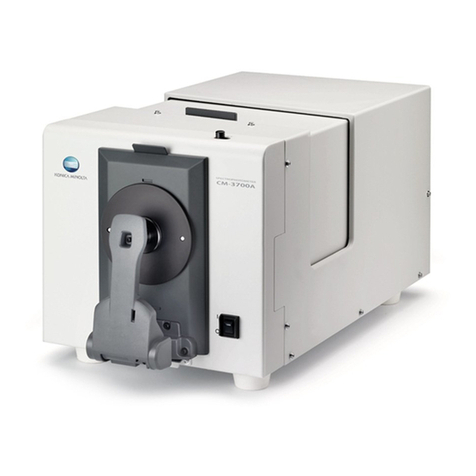
Konica Minolta
Konica Minolta CM-3700A instruction manual
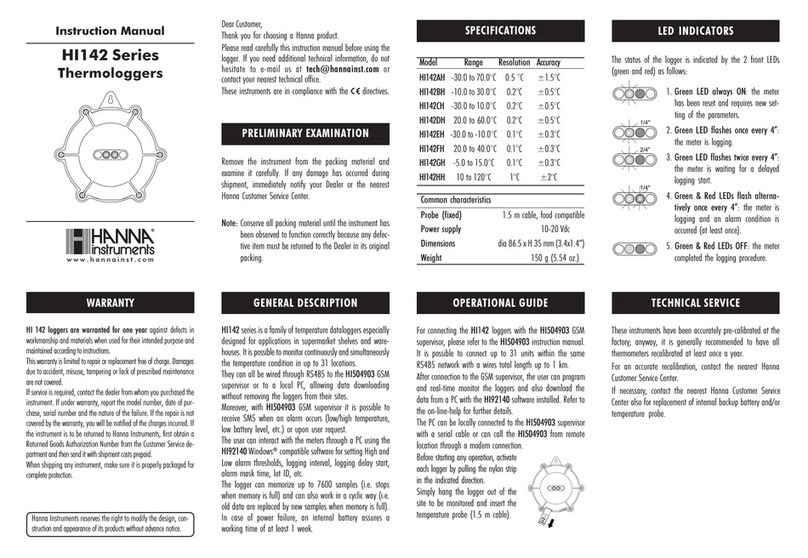
Hanna Instruments
Hanna Instruments HI 142 Series instruction manual
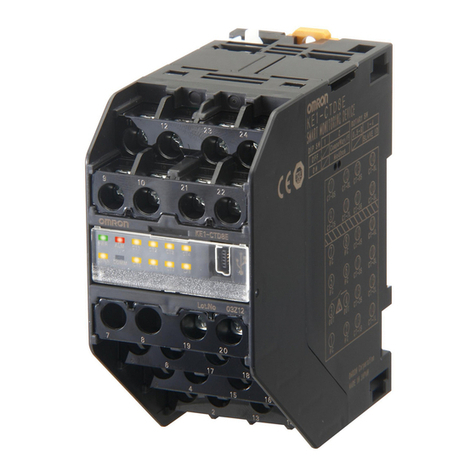
Omron
Omron KE1 user manual

Tektronix
Tektronix Keithley 4210-MMPC-L manual
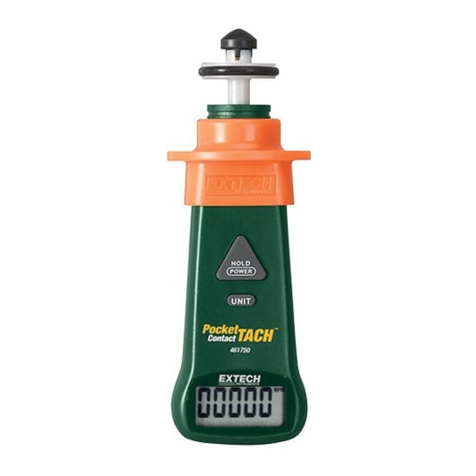
Extech Instruments
Extech Instruments 461750 user manual
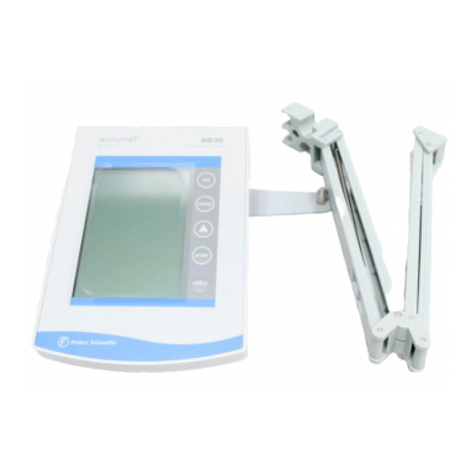
Fisher Scientific
Fisher Scientific Accumet Basic AB30 user manual

